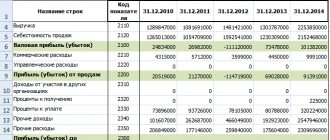Marketing research - what is it?
Marketing research is the work of a marketer that provides the company with the information it needs to operate. The competitiveness of a company is determined by the ability to work on the basis of accurate data, and not relying on intuition alone.
The task of marketing market analysis is to study the needs of the target audience. Then the company will offer consumers exactly the product they want. This means that the company will receive profit and a good reputation.
what to do for analysis
“So many scary words.” This is the phrase that comes to mind when I start reading the description of what needs to be done to conduct a marketing analysis:
- Conducting marketing research;
- Collection, processing and synthesis of data obtained as a result of research;
- Selection of key points from processed data;
- Conceptualization (Lord, what a terrible word!) – processing of key points and consideration in the right way;
- Extrapolation (who comes up with them!) – determining how this data will play out in the long term;
- Making conclusions.
I translate into human Russian, plus I immediately explain what needs to be done step by step in order to conduct a more or less human marketing analysis. Yes, it’s generalized, but it’s understandable.
- Marketing market analysis. Collect all the market information you can find and get your hands on.
Thanks to the Internet, you have almost all the information in the world. So search, it's not difficult. For example, I found all the current statistics I needed on accommodation in hotels/hostels/hotels in the city I needed. By the way, there was a rather interesting scandal recently. They decided to nominate a European student for the Nobel Prize, thanks to the results of the research he did. The scandal is that it is based on medical reports, rather confidential, but leaked to the Internet; - Marketing analysis of the company/organization/company. You study the entire organization from the inside. All, that means all! Marketing, sales, sales, production. Everything that happens within the company, all business processes. What if it suddenly happens that you set up marketing in a manufacturing company, but forget about production, and orders, instead of the required 3 days, will be completed in 10-14.
- Marketing analysis of competitors. Here! This is the most important thing for any manager and owner. Or rather, the most pleasant thing. Conduct an analysis of competitors and find out what they are better at in some way. Guys, let's do this, if we are to be better than our competitors, it will be in everything. This is why you study your competitors;
- Marketing analysis of the product. You need to determine how competitive and viable your product (in this case, this word includes both goods and services) will be when entering the market.
If an analysis of an organization is necessary, an analysis of competitors is interesting, then an analysis of a product is what the whole analysis is for, so study it in detail and consider all possible options; - Marketing analysis of the project. Everything here is simple and clear. You need to estimate and calculate how viable the entire project is in the long term (1-3-5-10 years), and whether it is worth starting.
WE ARE ALREADY MORE THAN 32,000 people. TURN ON
In-scale / marketing
Goals
The procedure includes searching, collecting and analyzing information. It is needed in order to make the product valuable to the consumer. The research is aimed at studying the potential buyer, namely:
- motives;
- values;
- traditions;
- emotions;
- preferences;
- expectations;
- habits.
The information obtained allows the company to understand its consumer. Based on this, products and their advertising are developed.
The main goal of marketing research is to provide businesses with initial information for making operational decisions while minimizing risks. This goal is made up of small steps:
- study consumer behavior;
- analyze information about the marketing problems of the enterprise;
- assess demand for products;
- study competitors in the market;
- evaluate the effectiveness of already carried out activities;
- predict demand for products in the future.
Each goal reflects a specific problem. For example, the goal of “assessing market capacity” sounds vague. This data will not help solve the problem of falling sales. The goal should be formulated differently - “to study consumer preferences and determine a workable way to increase sales.”
Structure and main stages of market analysis
During market research, a step-by-step study of all aspects affecting the activities of the enterprise is carried out. In order not to miss important points, a sequence of actions is drawn up, which in the future will make it easy to display your analysis in a business plan. It consists of the following stages:
- General overview of the industry;
- Target audience research;
- Study of the competitive environment;
- Analysis of potential opportunities;
- Analysis of possible risks.
Studying the industry and its prospects
At this stage, an analysis of the market as a whole is carried out, with reference to the specific region in which it is planned to operate. This does the following:
- Identification of market features . You need to determine what kind of activity we are talking about, what levels exist and what niche your company will occupy. It is also important to establish exactly how your product or service will fit into the market and what impact it will have on it.
- Volume and dynamics of development . It is necessary to note the scale of the market at the moment and its prospects in the future, whether it will develop or decline.
- Current problems of the industry . The main obstacles to development are identified. This may be a lack of logistics, infrastructure, complex legislation, and for new markets, lack of consumer knowledge of the product.
- The most promising areas of development . It is determined what can be offered new in the existing market format.
If a market analysis is being carried out for a business plan that will be presented to potential investors, it is advisable to provide qualitative indicators for the last five years. For example, industry dynamics can be demonstrated as a percentage of annual market volumes. Reports containing such information are often published by analytical agencies. When information is difficult to find, which may be due to the introduction of a new product or service to the market, it is permissible to provide data based on personal observations.
At this stage it is also important to determine what type of market you will face. Depending on the relationship between supply and demand, it can be positioned as a producer market and a consumer market. In the first case, when there is practically no competition, the seller of services or products sets the rules, and in the second, when there are a lot of offers, the main link is the buyer. In modern conditions, the second type of market often predominates, and due to the huge number of proposals, even when a new product enters, much attention is paid to the study of the consumer in the analysis.
How to conduct a consumer market analysis
This part of marketing market analysis is one of the most important, since it determines the entire future strategy of your business. First of all, the main target audience is identified. At the same time, your company can focus on the end consumer or other business representatives. In both cases, an assessment is made according to a number of criteria:
- Psychological and social . These include: lifestyle, social class, consumer motivation, status.
- Demographic . This category includes age and gender, marital status, cultural and religious values, type of activity, level of education, purchasing power and income.
- Geographical . Here it is important to take into account the place of residence of the potential buyer, the size of the locality, climatic conditions, media availability, level of development of the region, population density, current legislation, infrastructure and transport links.
Taking into account these criteria, segmentation is performed. It represents a breakdown of the market into separate areas according to a number of characteristics and similar purchasing power of consumers. The selected segments determine the pricing policy, the format of the advertising campaign and the marketing reach of the market. The latter can be of several types:
- Undifferentiated (mass) marketing - targeting products to all categories of the population without exception. Suitable only for those companies whose field of activity allows us to ignore the differences. For example, consumer goods or food.
- Product-differentiated - the company selects several market segments (categories of consumers), for each of which it develops its own characteristic strategy. This allows you to maneuver between market segments, focusing on the more profitable ones, but gradually expanding your sphere of influence and receiving additional profit at the expense of other segments.
- Concentrated marketing is choosing one segment and directing efforts towards it.
The choice of a market segment can be carried out on the basis of one’s own observations and logical conclusions or empirically (by researching various consumer groups and collecting information).
How information is collected to analyze the target audience
Modern marketers use in their practice the five most effective data collection formats to study the market and their consumers. To obtain high-quality information, the following can be carried out:
- Interview . To collect information, representatives of the study group are selected and an in-depth interview is conducted for each individual, revealing all aspects of open questions.
- Observation . The study of the behavior of a group representative is carried out directly in the process of implementing the activity under study. For example, to assess the demand for products and obtain data on the category of buyers, you can give a regular advertisement for sale and evaluate who and how often applies to the advertisement.
- Focus group . A group of representatives of the target audience is formed who express their opinions and comments on open issues in free form.
To collect quantitative data:
- Experiments . Practical testing of various hypotheses or tactics is carried out. Field research allows you to more clearly assess the effectiveness of a marketing idea and identify non-obvious problems in its implementation.
- Collection of statistical data and surveys . This method involves the use of strict uniform questionnaires designed to calculate average indicators. When obtaining statistical data, special attention is paid to accurately identifying the target audience.
These methods allow us to identify the consumer’s level of interest in a product, understand what qualities and capabilities he lacks in the product he is currently using, and how he feels about competing products. They can be implemented in practice in the following formats:
- Personal communication . This format is suitable for small businesses or those targeting a narrow market segment.
- On the Internet . You can obtain the necessary data by conducting surveys on social networks or by ordering them on special online resources for paid surveys. The disadvantage of this method is the high sampling error of the market segment.
- Observations . If your company is already operating, you can conduct research on how different categories of consumers buy your services or goods by collecting statistics.
- Use of data previously collected by other companies.
How to conduct market analysis taking into account competitors
By properly assessing the situation with competing products and services, you can minimize risks and quickly find your own niche in the industry. Conventionally, all competitors can be divided into:
- Direct - companies that carry out the same type of activity and target the same target audience within the same region as you.
- Indirect - companies for which the type of activity is similar to yours, is secondary, or is aimed at a different audience.
- Potential - companies with a similar type of activity, but operating in neighboring regions, provided that they can enter your market segment.
To perform a competitor analysis, a map is drawn up that determines the share of participation of each player in the market. While studying them you need to find out and analyze the following information:
- Pricing policy - statistics of prices for main and related products (services), how often prices are increased or decreased.
- The assortment and level of product quality - what advantages the competitor’s products or services have, why buyers give them preference.
- Marketing strategy - how to attract a client, what advertising campaigns are used.
- Distribution channels - how and where services or products are sold.
- Level of popularity in the market - how well-known your competitor is to consumers, whether his brand is recognizable.
- Market segment - who is the main buyer of your competitors.
- Suppliers and partners - who supplies raw materials or goods, which companies provide services (shipping, maintenance, etc.).
- Personnel composition and management system - what specialists are involved in the work, their level and remuneration, what enterprise management scheme is used.
- Strengths and weaknesses of a competitor - what are the advantages and disadvantages of products or goods according to consumers, as well as what are the risks of competitors in the market.
How to get competitor data
It is worth understanding that your competitors will not disclose the above information to you of their own free will, and therefore collecting it is quite difficult. On the other hand, competitor analysis will allow you to identify the strongest rivals, learn from their positive experiences and solve their problem areas in your favor.
A significant amount of information, especially on consumers, can be obtained in parallel with research into the target audience’s attitude towards your products, through surveys, focus groups or interviews. You can obtain some of the data through experimentation, by being a client of a competitor's company or by using a mystery shopper.
As in the case of studying the target audience, you can turn to special agencies involved in marketing research and who know how to do market analysis correctly, but their services are expensive and will only be profitable for large businesses.
How to analyze the market from the perspective of opportunities and risks
If marketing research has been carried out correctly, you can develop your own strategy based on it. This involves analyzing the strengths and weaknesses of your business and the market as a whole. Various methods can be used for this:
- SWOT analysis ( Strengths , Weaknesses , Opportunities , Threats ) . This is one of the most popular methods of strategic planning for an enterprise and analysis of its position in the market. It is a table with four blocks in which strengths (advantages of your product or marketing), weaknesses (advantages of competitors, your shortcomings), opportunities (solving problems existing in the market, using additional funds) and threats (level of competition, legislative framework, decline in market demand).
- PESTLE analysis ( Political , Economic , Social , Technological , Legal , Environmental ) . _ _ _ _ This method involves assessing the market from the perspective of political (laws affecting your business), economic (the general state of the economy and the standard of living of the population), social (is society ready for your product, cultural characteristics), technological (what innovations can be used and corresponds to Is your product up to date), legal factors (risks of copyright infringement), as well as the environment (geographical location, ecology). They are also listed in a table, indicating their impact on your business and the market as a whole.
- "Porter's Five Forces" . A method of strategic business planning with the identification of forces that most actively influence the attractiveness of the latter in the existing market. It involves analyzing five factors: the threat of substitute products appearing on the market, the threat of new competitors, the level of influence of suppliers of raw materials or products, the level of influence from consumers, the level of direct competition.
What problems do marketing research solve?
Criteria that the purpose of marketing research must meet:
- precise wording;
- studying the priority problems of the organization;
- the ability to solve problems in real conditions.
Conducting marketing research is necessary to solve many problems:
- introducing goods to new markets;
- updating existing products, developing new products;
- differentiation from competitors;
- increasing consumer loyalty;
- preventing clients from moving to competing organizations;
- control of market conditions;
- increasing advertising effectiveness;
- market segmentation;
- increasing brand reputation.
Solving problems is only possible with constant receipt of up-to-date information. You can research the market, the consumer, competitors, products, prices.
Marketing research independently or with the assistance of professionals
When deciding for yourself what is more profitable, your own research department or marketing outsourcing, you should take into account the price of the issue in relation to the volume of necessary research work and its regularity.
Hiring a specialist agency is expensive and is rarely available on a regular basis to small companies with limited marketing budgets. In such a situation, it is logical and optimal from the point of view of the expenses of the event to create your own marketing department. However, if there is no need to regularly monitor the market situation, hiring additional employees on staff entails large unreasonable expenses, and it is much more profitable to use the one-time service of a consulting company.
From an efficiency point of view, the advantages of contacting a research agency are obvious:
- extensive experience in conducting marketing research in various areas;
- unconditional professionalism of the specialists involved;
- high level of objectivity of the results obtained;
- the ability to use a variety of research methods or their combinations for maximum efficiency;
- high technical equipment and the availability of special equipment and programs for conducting the entire cycle of marketing research.
However, there is also an undeniable advantage of conducting research on your own - this is a high level of confidentiality when conducting internal research, since the circle of personnel involved in this type of activity is usually limited to 1-2 department specialists.
Types of marketing research
There are two main types of marketing research:
- Field – collection of primary information in the company’s environment. There are qualitative, quantitative and combined.
- Desk work - analysis of secondary information, study of reports and statistics.
Marketing research can be carried out by the company’s own department or a specialized agency. The advantages of conducting analysis “in-house” are lower costs and confidentiality. Disadvantages - lack of knowledge, low objectivity of analysis, imperfect technical equipment.
The advantages of contacting a specialized agency are the objectivity of the results and the work of qualified specialists. Disadvantages - high cost of work, risk of information leakage.
The procedure is classified according to the specific purpose:
- The exploration method is the collection of primary information. Based on it, the marketer identifies problems and puts forward their possible causes.
- Descriptive method - description of objects of study.
- The casual method is testing hypotheses using cause-and-effect relationships.
The procedure can be permanent to regularly monitor problems. Separate procedures are used to solve occasional problems.
How can I find out information about the market?
After you have compiled a list of questions that need to be answered, determine how to obtain the necessary information to prepare an analytical review of the market. Literally in a nutshell about existing opportunities, types and methods of market research in marketing:
Primary and secondary research on product markets
There are 2 types of market information that can be collected: primary and secondary data. Primary data is the initial information about the market, collected directly by the company during direct market research. Secondary data already exists in the market and has been collected by someone, and is often already processed and analyzed.
Fig.4 Primary and secondary market research
Any market analysis must begin with a study of existing secondary information about it. Perhaps research companies and government statistics agencies have already collected information to answer the questions in your analysis plan. If this is so, then you will significantly save time and budget for research.
So, don’t be lazy and spend an hour of your time searching for secondary market information on the Internet.
Quantitative and qualitative research methods
There are 2 ways to collect market information: quantitative and qualitative market research method.
Fig.5 Features of quantitative and qualitative market research
Quantitative market research methods in marketing provide structured and statistically processed information about the market. Using quantitative methods, you can obtain accurate numbers on the basis of which you can make a sales forecast or estimate the market size.
The result of qualitative methods of market analysis are hypotheses, ideas, and individual opinions that are not unstructured and cannot be statistically evaluated, but can only be analyzed subjectively.
5 types of market research
There are 5 methods of market research in marketing: surveys, focus groups, in-depth interviews, field research or experiments, and observations. The choice of research method depends on the budget and time resources. Briefly about each.
Fig.6 Types of market research
| Types of market research | Description of research methods |
| Surveys | They mean surveying the target market using a strictly specified questionnaire. The size can be both large and small. In a survey, the sample is important: the larger it is, the more correct and representative the result you will get. This is a quantitative method used when it is necessary to obtain an exact figure for a specific question. |
| Focus groups | A discussion or round table at which a given topic is discussed by a target group of consumers. There is a moderator who manages the discussion based on a given list of questions. The qualitative method is effective for understanding the causes of behavior, studying the hidden motives of the consumer, and helps formulate hypotheses. |
| In-depth interviews (personal interviews) | A conversation with one representative of the target audience on a specific list of open questions. They help to understand the issue in detail and form hypotheses. Qualitative research method. |
| Observation | Observing a representative of the target audience in his/her familiar environment (for example: video shooting in a store). Qualitative research method. |
| Experiments and field trials | Quantitative method of market research. Helps test certain hypotheses and alternatives in practice. |
Methods
Qualitative marketing research is carried out using the following methods:
- Focus group - discussion of a pre-developed scenario in a group of people with similar characteristics.
- An in-depth interview is a personal conversation with a consumer that does not have a pre-developed script.
- Neuromarketing is a survey using a technique that identifies a person’s unconscious reactions to marketing stimuli.
If necessary, qualitative results can be translated into quantitative ones.
Summing up
To summarize the above, it becomes clear that market analysis is the starting point for developing any business plan. Conducting marketing analysis is important both for developing strategic documents and identifying directions for long-term development, and for drawing up short-term plans for operational management purposes.
But conducting market analysis is both time-consuming and responsible. In order, firstly, to avoid serious mistakes, and secondly, not to waste your energy and time, we advise you to have a ready-made business plan in your chosen field. You can also contact specialists in the field of business planning, who will conduct a market analysis and develop a turnkey business plan, taking into account all the features of your enterprise.
Quantitative Research
Quantitative marketing research expresses the market situation in numbers. This is market research that answers the questions “who” and “how much”. The advantage is the ability to study a large number of people, increasing the reliability and objectivity of the information. The data obtained is processed using statistical methods and the results are extrapolated to all consumers.
Quantitative marketing research makes it possible to:
- estimate the monetary equivalent of market capacity;
- find out the distribution of competitors in the market;
- assess the prospects of the manufactured product.
To carry out quantitative methods, special questionnaires are used.
How to conduct research
Analysis of industry markets implies as its object a set of enterprises with interests in one sector of the economy. The so-called economic sector. It covers the production, distribution and consumption of specific services or goods.
And the purpose of this study is to identify industry risks. Analysis of the sales market should calculate the possibility and parameters of deviations in the results of a particular entity’s activities associated with the unstable situation of a specific industry market.
Table of main criteria:
How to do a comprehensive market analysis - this question is necessary for a clear idea of what will happen to the goods or services of a particular industry entity. The answer will consist of the following items:
- what are the market conditions (the relationships that are formed in the market during a certain period of time and existing trends);
- forecast of development and growth dynamics (for short-term forecasting, inertial processes are important; for long-term forecasting, the likelihood of changes in market activity is important);
- what is the market capacity (since it is impossible to sell more goods than can be bought in a certain territory, as a rule, the time period is taken equal to one year);
- research of competitors (understanding how much money will be spent to fight them, or to resist their fight);
- what is the volume of expected sales of goods or services (vital information for planning and organizing the functioning of a particular enterprise).
Stages of marketing research
The procedure is carried out in stages:
- Definition of the problem, correct formulation of the goals and objectives of marketing research.
- Development of a methodology based on key research parameters. The marketer determines the object of research, selects appropriate methods, and sets the sample size.
- Data collection. It is carried out under strict control, since the result of the procedure depends on the quality of the information collected.
- Analysis of the information received. The marketer processes the data and presents the results in a visual form.
Consumer research provides information about the factors that motivate people to make purchases. These include social status, education, and income level. Upon completion of the procedure, it becomes possible to segment consumers.
An example of a ready-made marketing plan for a trading company:
- Defining goals - identifying homogeneous groups of buyers, developing strategies for segmenting the consumer market.
- Setting objectives - identifying segmentation features, identifying market segments, defining a strategy for target market coverage.
- Collection of information - a questionnaire survey of four hundred people.
- Analysis of information, conclusions, recommendations.
The information is processed using standard programs, and the results are summarized in a table.
What is marketing analysis and why is it needed?
In the age of public access to information, people often start doing business “blindly”, without studying the competitor’s market, consumer profile, target audience, and so on. Aware means armed. To avoid problems at the stage of creating a business or if they have already arisen, I advise you to turn to marketing analysis.
Many will say that this is an expensive service, but believe me, it pays off very quickly. If you still do not intend to spend money, you can try to conduct this research of the enterprise yourself. Let's go over the basic concepts.
Marketing is a science that studies market needs for goods and/or services.
Marketing analysis is a comprehensive study of the market for products and services, as well as the development of an enterprise strategy.
Such a concept as “market” in the science of “marketing” has two, similar in spirit, meanings. The market, as a set of relations between the seller and the buyer, and the market, as a set of socio-economic relations, within the framework of which the satisfaction of all participants is achieved through trade turnover.
The entire science of marketing is based on the 4P theory.
What kind of theory is this?
It got its name because of four components:
- Product - product
- Price - price
- Promotion _
- Place - place.
Thus, the main goal of marketing analysis is to study all four components of the 4P theory and develop a further strategy for the enterprise.
Market analysis
Marketing market research includes analysis of the market industry, competitors, pricing policy, and turnover. The study of product distribution is necessary to find effective ways to sell products. The objects of the procedure are:
- intermediaries;
- distributors;
- direct sellers;
- selling methods;
- transportation of products;
- wholesale and retail trade.
Based on the data obtained, the marketer determines the possibility of increasing turnover, optimizing warehouses, and developing criteria for selecting distribution channels.
Market analysis includes the study of sales promotion systems:
- behavior of suppliers and intermediaries;
- effectiveness of marketing activities;
- advertising effectiveness.
The data obtained allows us to generate demand for products and increase the efficiency of communication with consumers.
Types of market:
- Producer market - organizations that buy goods or services for their work.
- Consumer - people buying goods or services for personal use.
- State - organizations that are the property of the state.
- Intermediary - organizations that buy goods or services for resale.
The market is domestic and international.
Objectives of marketing analysis
Marketing scientists identify 7 main tasks of marketing analysis. Let's take a closer look at each of them.
1. Market research and justification of market growth/decline trends
As you already understand, the concept of “market” in marketing does not mean the place where goods are sold, but the totality of relationships between the seller and the consumer, each of which has its own goals and objectives, needs, material values, and so on. Thus, the task of market research is complex: from competitors to consumers.
2. Analysis of the main factors influencing the demand for goods/services
There can be an endless variety of factors that can affect the demand for a particular product or service. It may be affected by seasonality, opening hours, incorrectly identified target audience, incorrect pricing policy, non-target promotions, and so on. This task lies in identifying, studying and eliminating problems.
3. Enterprise pricing analysis
This task is one of the key and priority ones in analyzing the company’s marketing activities. Using certain methods, a trend of rising or falling prices is identified, a comparative analysis of competitors' prices is carried out, and through calculations the prices that are most favorable for the seller and consumer in a given period of time are verified.
4. Study and identification of real and potential competitors of the enterprise
Often, entrepreneurs, without properly studying the competitive environment and the competitiveness of their company, make serious mistakes in building a business development strategy. Solving the problem of studying and identifying real and potential competitors contributes to a competent balance of power, as well as the formation of a unique selling proposition that will distinguish your organization from many others.
5. Assessing the competitiveness of the enterprise as a whole, identifying ways to increase competitiveness
6. Conducting a full SWOT analysis
SWOT analysis is the study of a business's strengths and weaknesses, as well as opportunities and threats. SWOT analysis is one of the marketing analysis tools and helps you see the full picture.
SWOT analysis is an assessment of the internal and external state of a company, allowing you to clearly see all the strengths and weaknesses.
- S tendths – strengths;
- Weakness – weaknesses;
- O pportunities - opportunities;
- T threats - threats.
You can see a clear example of a SWOT analysis in this article.
7. Selection of the most effective methods and forms of product sales, development of a marketing strategy for the enterprise
Thus, we have identified 7 main tasks of marketing analysis, having solved which, it will be possible to see the full picture of the enterprise’s activities, both its internal and external aspects.
Competitor analysis
Marketing research of competitors provides information to gain an advantage in the market. Using this data, you can find common ground with competitors and determine the possibility of cooperation.
Analysis tasks:
- study the strengths and weaknesses of competitors;
- determine the market share they occupy;
- determine the consumer's reaction to the marketing actions of competitors.
From the information received, you can get ideas for improving the work of your own company.
What to do with the research done
All information obtained during marketing research must be checked for accuracy and relevance to the issue, systematized and analyzed in a certain way.
The essence of analysis is the processing of received information by converting data into meaningful facts. This procedure consists of two stages:
- All received data is entered into a computer, checked for errors, encoded and output in the form of a matrix.
- Statistical analysis of the obtained values.
Having received statistical data, specialists prepare a report on the results of the study, making their comments and recommendations. Finally, there are also conclusions and predictions regarding the solution to the original research problem.
Product Analysis
Product analysis is carried out to assess the compliance of product quality with consumer needs. The analysis provides information from the buyers' point of view. Based on this data, the company can adjust its products and develop a new advertising campaign.
During product analysis, the following is studied:
- similar products of competitors;
- buyer attitude towards new products;
- range;
- service;
- new customer needs.
At the same time as product analysis, prices are analyzed. The task of price analysis is to find a price ratio that will allow you to get maximum profits at minimum costs. You need to study the costs of development, production, and distribution of the product. You will need to monitor competitors' prices and customer reactions to price fluctuations.
Generating a report
This is the final part of the marketing analysis, which allows you to understand to what extent the main tasks were completed and what conclusions can be drawn based on the work done. The report must contain data directly about the market, the activities of the company and competitors, the profitability of the product being sold, and consumer demand.
What is the result
The result of studying a product is to identify strengths and weaknesses and increase its competitiveness. The manufacturer can adjust the range and improve the quality of the product.
A ready-made example of studying the products of a handmade cake store:
- high competition;
- large customer requests;
- the need to regularly update the assortment;
- production costs.
The store retains customers with high-quality cakes with original design and affordable prices. To differentiate yourself from competitors, you need to hold promotions and give discounts to regular customers.
Marketing research is necessary for a company that wants to succeed. A competent procedure reduces the risk of making the wrong decision, increases product sales, and secures the organization’s place among competitors.
Form style
Naming
Package design
Brand book
Brand audit
Brand strategy










